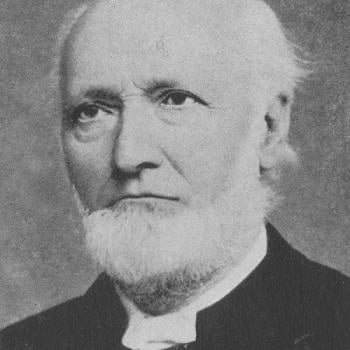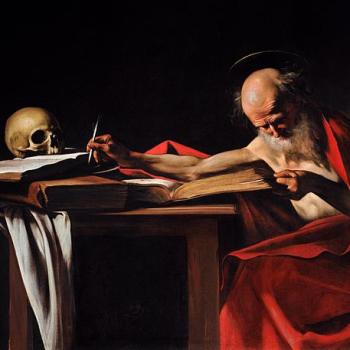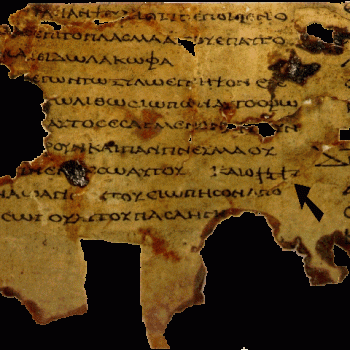*
His words will be in blue. Translations from the Portugese of his book will be made with Google Translate (with an occasional additional modification). I will use RSV for Bible translations.
Just as the Christian church received the Old Testament from the Jews, recognizing that the scriptures already had their own authority, the early church received letters from the apostles in the same way. (p. 37)
[T]he Christian Church did not make the Bible inspired and did not even make it the Word of God, but merely recognized the canon, how the sheep recognize the voice of their Shepherd (John 10.4,16). (p. 50)
The great debate about the doctrine of Sola Scriptura entails a very simple question: evangelicals will say that scripture has authority in itself; the biblical text in this way is authoritative. We believe that no one needed to give authority to the scriptures, but that the scripture already has authority because it is the revelation of God. For Roman Catholics it is not quite like that: it is taught that Catholics chose and defined the scriptures and in the process created the Canon of the New Testament. It is common to hear many Catholics saying that it was the church that gave us gave the Bible and that the church gave us the New Testament Canon, . . . (p. 60)
The writings already had authority; what the church did was find them. This overthrows the entire Roman fallacy that the Catholic church gave the Canon. In truth, the Canon was assembled from books that already had authority, without need of the church . . . (p. 66)
The Catholic Church, in fact (as opposed to the caricatured myth above), taught the following in no uncertain terms, in two ecumenical councils:
These the Church holds to be sacred and canonical; not because, having been carefully composed by mere human industry, they were afterward approved by her authority; not because they contain revelation, with no admixture of error; but because, having been written by the inspiration of the Holy Ghost, they have God for their author, and have been delivered as such to the Church herself. (Vatican I [1870], Dogmatic Constitution on the Catholic Faith, chapter II; emphasis added)
The divinely-revealed realities which are contained and presented in the text of sacred Scripture, have been written down under the inspiration of the Holy Spirit. For Holy Mother Church relying on the faith of the apostolic age, accepts as sacred and canonical the books of the Old and New Testaments, whole and entire, with all their parts, on the grounds that they were written under the inspiration of the Holy Spirit (cf. Jn. 20:31; 2 Tim. 3:16; 2 Pet. 1:19-21; 3:15-16), they have God as their author, and have been handed on as such to the Church herself. (Vatican II [1962-1965], Dogmatic Constitution on Divine Revelation [Dei Verbum], Chapter III, 11; emphasis added)
Has Juan ever even noticed these two statements before? Not likely. Well, now he is aware of them (assuming he even reads any of my critiques: having avoided making any reply to my first six).
The justification was that Jesus and the apostles used the Septuagint, so the church should too, accepting the deuterocanonical books as inspired by God. (p. 37)
I would say that apostolicity is a pretty good — even compelling — justification. Why would that even be controversial? But since it conflicts with man-made portions of Protestant tradition in this case, it’s objectionable, and Juan goes on to argue that Jewish opinions on canonicity overrule apostolic Christian ones. The New Testament, by the way, massively cites the deuterocanon. Some of the following possible references are speculative, but all taken together show the strong influence:
In the second century it was read and appreciated by Christians who were disposed to take it at face value as composed by Peter. Even Justin Martyr appears to quote it in one place. (p. 200)
Bruce states that St. Clement of Alexandria even quoted from the “thoroughly gnostic” Gospel According to the Egyptians “not once but four times” (p. 189). The same father (exercising what Bruce calls “hospitality”) approvingly cited Traditions of Matthias and Sibylline Oracles (p. 191). He also quoted uncanonical sayings of Jesus, known as agrapha.
Brooke Foss Westcott (A General Survey of the History of the Canon of the New Testament: Grand Rapids, Michigan: Baker Book House, 6th edition, 1980, from 1889 edition, 110-111; cf. Bruce, ibid., 127) notes that Justin Martyr also repeatedly cites a work called Memoirs of the Apostles (e.g., ten times in his Dialogue With Trypho).
St. Athanasius thought The Didache was good enough to include alongside the canonical books, in the same list where he first lists the 27 NT books, and to be profitably read in churches for edification (Bruce, ibid., 209). St. Cyril of Jerusalem (d. 386) took the same position (ibid., 211), as did Rufinus (d. 410) (ibid., 225).
Non-canonical books regarded as canonical by Church fathers and collections of books, include Epistle of Barnabas (Clement of Alexandria, Origen, Codex Sinaiticus, late 4th c.), Shepherd of Hermas (Irenaeus, Tertullian, Origen, Clement of Alexandria, Codex Sinaiticus), and The Didache (Clement of Alexandria, Origen, Athanasius), 1 Clement, 2 Clement (Codex Alexandrinus, early 5th century).
Just as all these books were believed to be part of the canon by prominent early Church figures, so there were variations in the LXX as well. Much ado about nothing. The Church had to authoritatively recognize the canonical books, in any event. Men on their own, without the guidance of the Holy Spirit, were clearly unequal to the task. And by the way, a “Catholic” (yours truly) “told” you all this. The truth is always far more interesting than myths and propaganda and selections of just a small amount of the relevant data.
So I ask the following question: where does the Septuagint represent the exact canon that the Catholic Church now assumes for itself? None of versions of the Septuagint that we have today represent exactly the list ofbooks that the Catholic Old Testament has. (p. 38)
As mentioned, all of these included the seven that the Catholic Church declared to be canonical, just as the Church fathers also thought many books to be canonical, that the Church later declared not to be. Famously, no one listed all 27 NT books and only those, as canonical, until St. Athanasius in 367 AD: some 33o or so years after the death of Christ.
The Jews had their established canon, called Tanakh, which is theSame thing as the Protestant Old Testament. (p. 38)
There was a “general” canonical consensus with regard to the New Testament, but that wasn’t sufficient to resolve the problem. Likewise, there was a general consensus of the Jews with regard to the Old Testament which wasn’t totally sufficient, either. Accordingly, Protestant biblical scholarship tells us that in the last four centuries before Christ:
It is clear that in those days the Jews had holy books to which they attached authority. It cannot be proved that there was already a complete Canon, although the expression ‘the holy books’ (1 Macc. 12:9) may point in that direction. (The New Bible Dictionary, ed. J. D. Douglas, Grand Rapids, Michigan: Eerdmans, 1962 ed., 190, “Canon of the Old Testament”)
As for the New Testament period:
More than once the suggestion has been made that the synod of Jabneh or Jamnia, said to have been held about AD 90, closed the Canon of the Old Testament and fixed the limits of the Canon. To speak about the ‘synod of Jamnia’ at all, however, is to beg the question . . . It is true, certainly, that in the teaching-house of Jamnia, about AD 70-100, certain discussions were held, and certain decisions were made concerning some books of the Old Testament; but similar discussions were held both before and after that period . . . These discussions dealt chiefly with the question as to whether or not some books of the Old Testament (e.g. Esther, Proverbs, Ecclesiastes, Canticles, Ezekiel) ‘soiled the hands’ or had to be ‘concealed’ . . . As regards the phrase ‘soil the hands’, the prevailing opinion is that it referred to the canonicity of the book in question . . . If indeed the canonicity of Esther, Ecclesiastes, and Canticles was disputed, we shall have to take the following view. On the whole these books were considered canonical. But with some, and probably with some Rabbis in particular, the question arose whether people were right in accepting their canonicity, as, e.g., Luther in later centuries found it difficult to consider Esther as a canonical book . . .We may presume that the twenty-two books mentioned by Josephus are identical with the thirty-nine books of which the Old Testament consists according to our reckoning . . . For the sake of completeness we must observe that Josephus also uses books which we count among the Apocrypha, e.g. 1 Esdras and the additions to Esther . . . (Ibid., 191)
The Jews of the Dispersion regarded several additional Greek books as equally inspired, viz. most of the Books printed in the AV and RV among the Apocrypha. During the first three centuries these were regularly used also in the Church . . . St. Ambrose, St. Augustine, and others placed them on the same footing as the other OT books. (Oxford Dictionary of the Christian Church, Oxford University Press, ed. F. L. Cross and E. A. Livingstone, 1989, 232, “Canon of Scripture”)
In the Septuagint (LXX), which incorporated all [of the so-called “Apocryphal” books] except 2 Esdras, they were in no way differentiated from the other Books of the OT . . . Christians . . . at first received all the Books of the Septuagint equally as Scripture . . . Down to the 4th cent. the Church generally accepted all the Books of the Septuagint as canonical. Gk. and Lat. Fathers alike (e.g., Irenaeus, Tertullian, Cyprian) cite both classes of Books without distinction. In the 4th cent., however, many Gk. Fathers (e.g. Eusebius, Athanasius, Cyril of Jerusalem, Epiphanius, Gregory of Nazianzus) came to recognize a distinction between those canonical in Heb. and the rest, though the latter were still customarily cited as Scripture. St. Jerome . . . accepted this distinction, and introduced the term ‘apocrypha’ for the latter class . . . But with a few exceptions (e.g., Hilary, Rufinus), Western writers (esp. Augustine) continued to consider all as equally canonical . . . (Ibid., 70-71, “The Apocrypha”)
The early Christian Church inherited the LXX, and the NT writers commonly quoted the OT Books from it . . . In post-NT times, the Christian Fathers down to the later 4th cent. almost all regarded the LXX as the standard form of the OT and seldom referred to the Hebrew. (Ibid., 1260, “The Septuagint [‘LXX’]” )
The suggestion that a particular synod of Jamnia, held c. 100 A.D., finally settled the limits of the OT Canon, was made by H.E. Ryle; though it has had a wide currency, there is no evidence to substantiate it. (Ibid., 726, “Jamnia or Jabneh”)
It is probably unwise to talk as if there was a Council or Synod of Jamnia which laid down the limits of the Old Testament canon . . . A common, and not unreasonable, account of the formation of the Old Testament canon is that it took shape in three stages . . . The Law was first canonized (early in the period after the return from the Babylonian exile), the Prophets next (late in the third century BC) . . . the third division, the Writings . . . remained open until the end of the first century AD, when it was ‘closed’ at Jamnia. But it must be pointed out that, for all its attractiveness, this account is completely hypothetical: there is no evidence for it, either in the Old Testament itself or elsewhere. We have evidence in the Old Testament of the public recognition of scripture as conveying the word of God, but that is not the same thing as canonization. (F. F. Bruce, The Canon of Scripture, Downers Grove, Illinois: InterVarsity Press, 1988, 34, 36)
The Encyclopedia Britannica noted the “fluidity” of Jewish notions of the canon for some two generations after the apostolic age:
Differences of opinion also are recorded among the tannaim (rabbinical scholars of tradition who compiled the Mishna, or Oral Law) and amoraim (who created the Talmud, or Gemara) about the canonical status of Proverbs, Song of Songs, Ecclesiastes, and Esther. All this indicates a prolonged state of fluidity in respect of the canonization of the Ketuvim [“the Writings”]. A synod at Jabneh (c. 100 CE) seems to have ruled on the matter, but it took a generation or two before their decisions came to be unanimously accepted and the Ketuvim regarded as being definitively closed. (1985 ed., vol. 14 [Macropedia], 758, “Biblical Literature,” “Old Testament canon, texts, versions”)
The Jews were still arguing about the canonicity of books written before 400 B.C. as late as 170-180 AD, and had to rely on the previous judgments of scholars in Jamnia to finally decide the issue. Likewise, Christians had to rely on the authoritative “human” judgments of the Councils of Carthage (397) and Hippo (393) and of Rome (in 382) to resolve their disputes, which lasted about nine generations, over the ongoing development of the New Testament canon. Our disputes over our canon, then, took almost as long as the Jewish disputes over theirs (almost 300 years from the end of the apostolic age, and 365 or so from the death of Jesus).
St. Athanasius listed all 27 NT books, but what is much less known is that when he listed the Old Testament books, they were not identical to the Protestant 39:
As Athanasius includes Baruch and the ‘Letter of Jeremiah’ . . . so he probably includes the Greek additions to Daniel in the canonical book of that name, and the additions to Esther in the book of that name which he recommends for reading in the church, . . . Only those works which belong to the Hebrew Bible (apart from Esther) are worthy of inclusion in the canon (the additions to Jeremiah and Daniel make no appreciable difference to this principle . . . In practice Athanasius appears to have paid little attention to the formal distinction between those books which he listed in the canon and those which were suitable for the instruction of new Christians [he cites Wisdom of Solomon, Wisdom of Sirach, Esther, Judith, and Tobit] . . . and quoted from them freely, often with the same introductory formulae – ‘as it is written’, ‘as the scripture says’, etc. [footnote 46: He does not say in so many words why Esther is not included in the canon . . . ] (Bruce, ibid., 79-80)
[T]he canon of the Old Testament was received from the Jews and since Jesus was a Jew, he followed the canon thatbelonged to the Jews, which was already established at that time. (p. 38)
Ah, but it wasn’t established till the late 2nd century, per my above documentation, from all Protestant scholars. Juan — consistent with his method in most of this chapter — doesn’t give any evidence that Jesus only accepted the Protestant 39 books and no others. The great Protestant scholar, F. F. Bruce, is not nearly as confident as Juan (“armed” as he is with no evidence and mere bald assertions). He wrote that we cannot be sure whether Jesus accepted, for example, “Esther, Ecclesiastes or the Song of Songs as scripture, because the evidence is not available” (F. F. Bruce, The Canon of Scripture, Downers Grove, Illinois: InterVarsity Press, 1988, 41).
But a good argument can be made that Jesus cited the deuterocanonical books or at the very least had them in mind. And He often cited Jewish rabbinical and non-biblical sources also, as I proved in Part 1 of this series.
Paul believed that oracles of God, which is the Old Testament, were entrusted only to Jews. So yes, it matters a lot what the Jews believed about the canon andthe Catholic church has no power to change this. (p. 38)
We don’t deny this. But in any event, the Jews hadn’t decided on their canon during the time of Jesus or the apostles; not in the entire first century AD, nor even during much of the second century.
That is why we Protestants follow the canon of the Jews, which is theTanakh, because the apostles believed in the canon of the Jews. (p. 39)
That’s impossible, as shown, since the Jewish canon wasn’t yet closed. We don’t know every particular book that they regarded as canonical.
Catholicism claims that its canon was established at the Council of Rome, under the command of “pope” Damasus I, in the year 382 A.D. However, the council of Rome was merely regional, and at the same time, several other regional councils tried to define a list of the biblical canon. So there were several disagreements at the time, and because the council of Rome was not ecumenical, not all of the church completely agreed with it. (p. 40)
The canonical list from the Council of Rome in 382, which is identical to Trent’s canon, includes: Wisdom, Ecclesiasticus, Tobit, Judith, and 1 and 2 Maccabees. Baruch was included as part of Jeremiah, as in St. Athanasius’ list of fifteen years previously. The Council of Carthage in 397 accepted the same list, as detailed by Brooke Foss Westcott (A General Survey of the History of the Canon of the New Testament, Grand Rapids, Michigan: Baker Book House, 1980, rep. from 6th ed. of 1889, 440). So did the Sixth Council of Carthage (419). In 405, Pope Innocent I affirmed the canon of 382 (Rome), 393 (Hippo) and 397 (Carthage) in his letter addressed to Exsuperius, bishop of Toulouse (see Bruce, ibid., p. 97). In this way, papal authority ratified regional conciliar authority.
Even St. Jerome, translator of the Latin Vulgate (Catholics’ Bible), did not accept many of these seven additional books, and even made a distinction between them. . . . Even though he translated the books of the Septuagint, it does not mean that Saint Jerome believed that all of them were canonical, . . . (p. 41)
This is more complex than Juan and most Protestant apologists assume. My good friend and fellow Michigander apologist Gary Michuta, in his excellent book, Why Catholic Bibles are Bigger (2nd edition: Catholic Answers Press, 2017) observed about St. Jerome:
He . . . flatly denies that Tobit is part of the canon, [1] although elsewhere he cites it without qualification! [2] . . . Jerome adopts the popular convention in his Letter to Oceanus by quoting Baruch as a voice made by “the trumpets of the prophets.” [3] Sirach is both rejected and quoted as Scripture, [4] although it is formally quoted [5] and occasionally used without qualification. [6] Wisdom is also occasionally formally quoted. [7] Jerome even attributes the passages from Wisdom to the Holy Spirit. [8] Maccabees is used without distinction. [9] Jerome at times alludes to the Deuterocanonical sections of Daniel in his letters. [10] Deuterocanonical passages from Esther are likewise quoted. [11] . . . he lists Judith as one of the virtuous women of sacred Scripture . . . [12].
[1] Prologue to John.
[2] Commentary in Eccles. 8.
[3] Letter 77:4.
[4] Commentary on Isaiah, Book 2, 3:12; Letters 77:6: 108:22; 118:1; 148:2,16,18.
[5] Commentary on Jeremiah, Book 4, 21:14; Commentary on Ezekiel, Book 6, 18:6; and Letter 64:5.
[6] Commentary on Isaiah, Book 8, 24:4; Commentary on Ezekiel, Book 6, 18:6; Letter 57.1 To Pammachius; and Letter 125.19, To Rusticus.
[7] Commentary on Isaiah, Book 1, 1:24; Commentary on Zechariah, Book 3, 14:9; and Commentary on Malachi, 3:7 ff.
[8] Commentary on Galatians, Book 1, 3:2 . . . and Breviarium in Psalmos, Ps 9.
[9] Against Pelagians, Book 2:30; Letter 7, To Chromatius, Jovinus and Eusebius.
[10] Letter 3, 1 To Rufinus the Monk; Letter 22,9-10, To Eustochium; Letter 1, 9 to Innocent.
[11] Letter 48, To Pammachius, 14.[12] Letter 65,1. (from the first edition: Port Huron, Michigan: Grotto Press, 2007, 149-150; my own footnote numbering)
F. F. Bruce noted about St. Jerome and the biblical canon:
[H]e was quite happy, not only in his earlier works but in some of the latest, to quote from them [the deuterocanonical books] with the same introductory formulae as he used when quoting from the ‘Hebrew verity’ or the New Testament books. He is capable of such obiter dicta as: ‘Ruth, Esther and Judith have been given the great honour of conferring their names on sacred volumes.’ (Bruce, ibid., 93; citing Jerome from Epistle 65:1).
Even Martin Luther and John Calvin state many times that various deuterocanonical books are “Scripture” or part of the canon or inspired or involve true “prophets” and suchlike.
*
*
Summary: Juan Oliveira makes lousy arguments with hardly any backing substantiation, regarding the biblical canon. I provide massive Protestant scholarly documentation.













